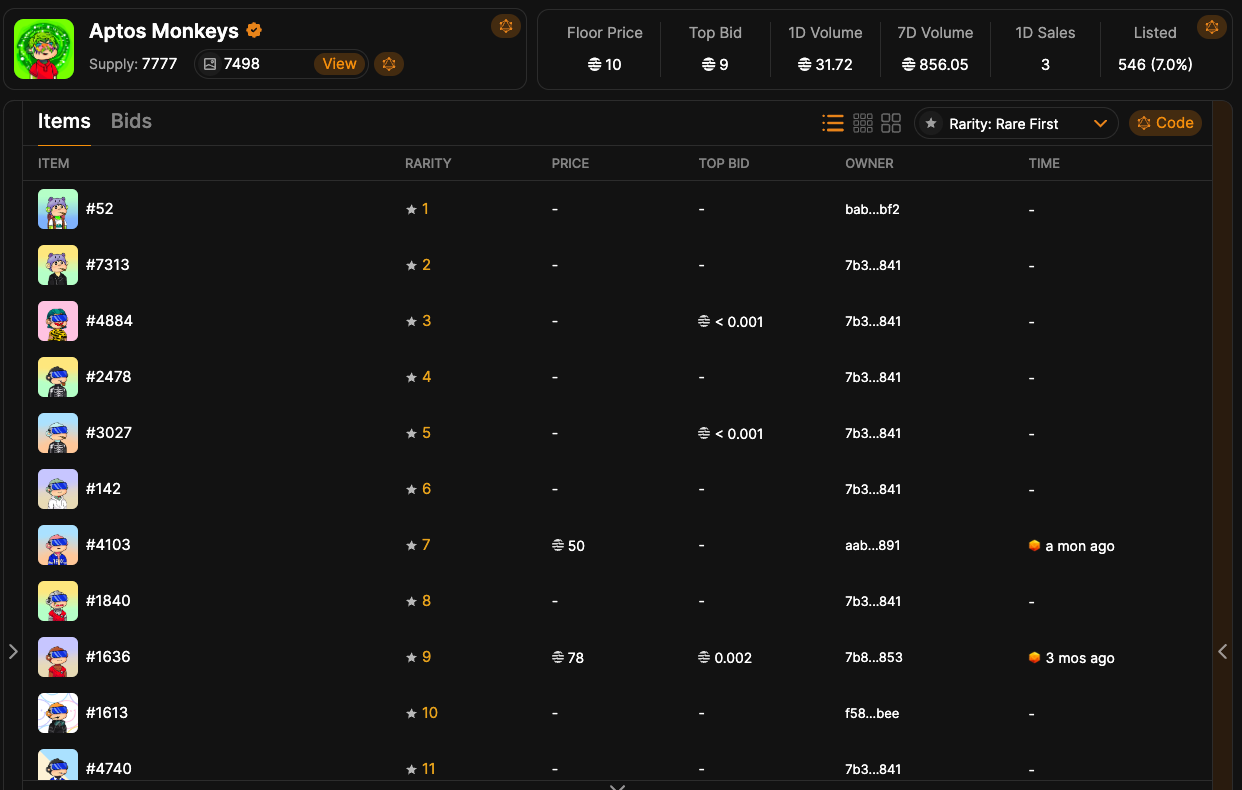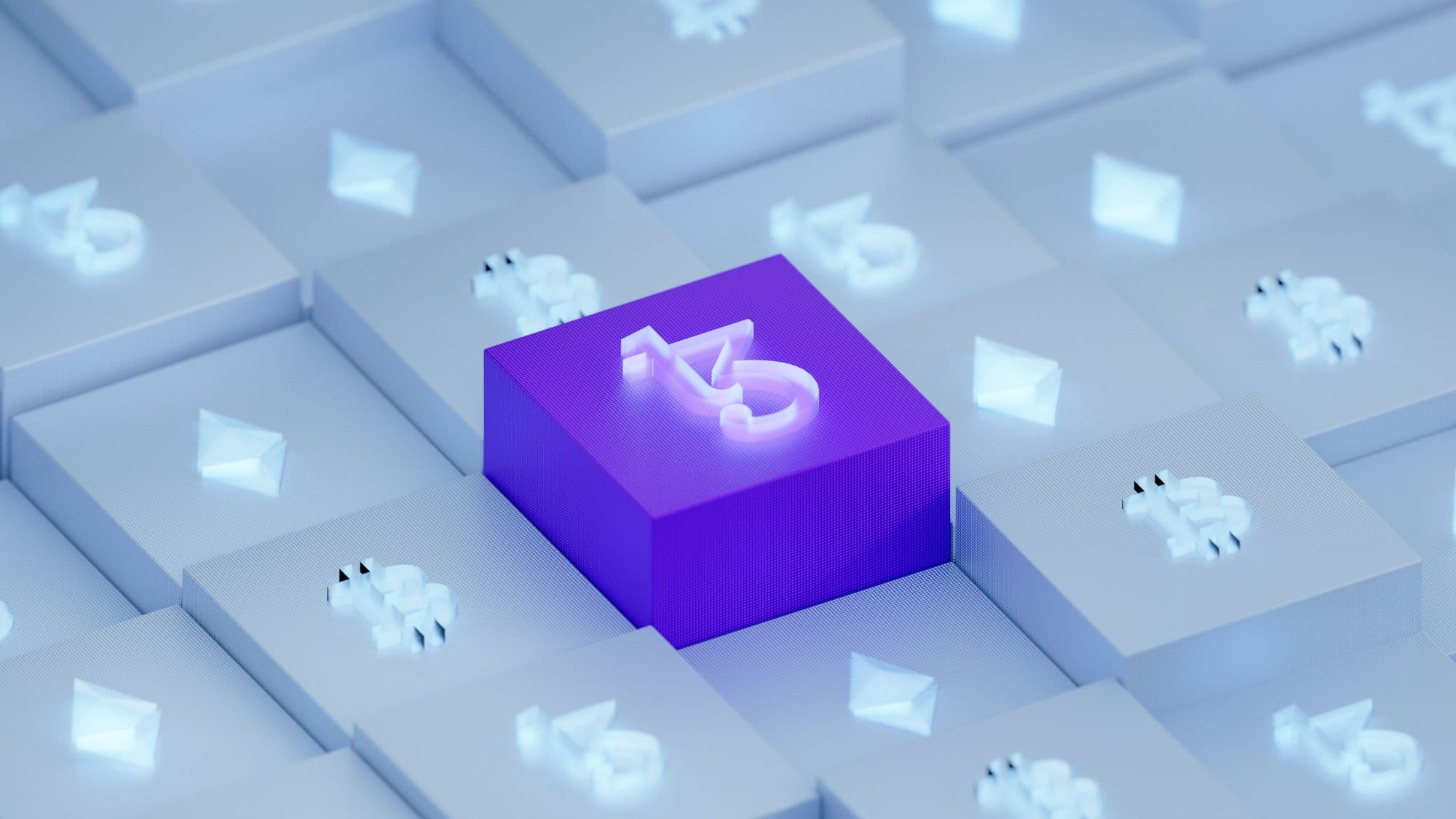
In the diverse and ever-evolving realm of Non-Fungible Tokens (NFTs), the concept of rarity is critical. It plays a crucial role in determining the value of an individual NFT. Collectors are often found rummaging through various discords of NFT projects, asking one common question – 'how rare is my NFT?' A question that sounds simple, yet the answer is far from it. At Indexer.xyz, we use a method called Rarity Score, created by Rarity.tools.
Deciphering the Rarity Conundrum
Take a look at any collectible NFT on TradePort.xyz, such as a piece from the Aptos Monkeys collection, you will notice it has many properties or traits. You might be able to identify that an NFT has some rare traits, but how rare is it compared to others? This question arises because each NFT has multiple traits and you need a method to amalgamate the rarity of all these traits into one single value per NFT.
Various methods have been developed to rank NFTs by rarity: Trait Rarity, Average Trait Rarity, Statistical Rarity, and Rarity Score (popularized by Rarity.tools and what we use at Indexer.xyz).
Trait Rarity Ranking
This method revolves around comparing NFTs by simply contrasting the rarest trait of each NFT. While it is a straightforward method, it only considers the rarest trait, thereby not providing a comprehensive understanding of an NFT's rarity.
Let's consider two hypothetical NFTs, each having four traits. The Trait Rarity method would favor the NFT with a single ultra-rare trait, neglecting the overall rarity of the other traits. But wouldn't the other NFT, which has more overall rarity, be valued more? This lack of comprehensiveness is a glaring weakness of the Trait Rarity method.
Average Trait Rarity
This method takes a more holistic approach by averaging the rarity of all traits present on the NFT. However, this method heavily leans on the overall rarity of every trait, causing NFTs with a single ultra-rare trait to be undervalued, as their rarity value gets too diluted by the other traits.
Consider a collection of ten NFTs, each having four traits. Average Trait Rarity would rank four duplicate NFTs as rarer than the single unique NFT in the collection, contradicting the intuitive understanding of rarity.
Statistical Rarity
Statistical Rarity is a method that gained popularity for a time during JPEG summer in 2021. It calculates the overall rarity of an NFT by multiplying all of its trait rarities together. However, like Average Trait Rarity, this method also tends to undervalue NFTs with a single ultra-rare trait.
For instance, if we apply this method to the same collection of ten NFTs mentioned before, Statistical Rarity too suggests that the four duplicate NFTs are rarer than the unique one. A clear misjudgment of rarity.
Rarity Score
In 2021, Rarity.tools introduced the Rarity Score calculation, now somewhat of a standard in the industry and used as the basis for rarity ranking on Indexer.xyz, TradePort.xyz, and many other NFT platforms.
Rarity Score calculation is a straightforward process:
Rarity Score for a Trait Value = 1 / (Number of Items with that Trait Value / Total Number of Items in Collection)
This approach considers both the overall rarity of traits and the impact of single ultra-rare traits, aligning more closely with our intuitive understanding of rarity.
Rarity Score: A Comprehensive Method
Rarity Score successfully identifies the NFTs with the most unique traits as the rarest, a result that aligns with our instinctive judgement.relationship with other factors like aesthetics, utility, historical significance, and more.
Each method of rarity calculation has its benefits and drawbacks, and it is crucial to understand them when engaging in the NFT space. It's also essential to remember that while rarity is a significant factor in an NFT's value, it is not the only consideration. Other factors such as the reputation of the creator, demand in the market, the aesthetics of the piece, and its utility or functionality can also greatly influence its value.
To recap, we have looked at four different methods of calculating NFT rarity:
- Trait Rarity Ranking: This method is simple and straightforward, but it only takes into account the rarest trait of an NFT. This can result in a skewed perception of rarity as it does not consider all traits.
- Average Trait Rarity: This approach averages the rarity of all traits on an NFT, providing a more comprehensive view. However, it tends to undervalue NFTs with a single exceptionally rare trait as it averages this out with the other more common traits.
- Statistical Rarity: This method multiplies all trait rarities together, which can emphasize the overall rarity of an NFT. However, like Average Trait Rarity, it can undervalue NFTs with one super rare trait.
- Rarity Score: This approach was developed by the founder of rarity.tools and provides a balance between considering overall trait rarity and giving appropriate weight to individual rare traits.
So, is there a one-size-fits-all solution to NFT rarity calculation? The short answer is no. Each method has its strengths and weaknesses and might be better suited to different types of collections or specific use cases. Therefore, understanding these methods and their potential applications is key for anyone involved in the NFT space.



